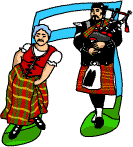Scottish Country Dancing
Created | Updated May 12, 2004

A late 1990s BBC documentary exploring the question of 'what makes people happy' concluded that the activity generating the greatest degree of happiness in its participants was Scottish country dancing. The aerobic demands of this type of dancing are considerable, and enthusiasts of all ages tend to be physically fit. So here is a hobby that is officially more fun than sex and also better exercise. What's more, you are not only allowed to change partners - it would be impolite not to.
Types
Revived in the 19th Century, it has become the crème de la crème of folk dancing. There are hundreds of specific dances, most having a greater degree of complexity than other folk dance forms. The four main types of dance are:
- The Reel - four quick beats in each bar.
- The Jig - six quick beats in a bar.
- The Hornpipe - two beats in a bar.
- The Strathspey - four beats in a bar, slow and elegant.
The first three are danced to a brisk 'travelling step' (hop, step, close, step; with the two 'steps' on the beat) and setting step (on the spot, to the same rhythm). The Strathspey uses a more measured travelling step (step, close, step, hop; all on the beat) and setting step (side to side, same rhythm).
Formations
Dances are in various formations of six, eight and sometimes ten people. The most common is a set of four couples, men (or women masquerading as men) on one side and women on the other, with three couples dancing at any one time. After each repetition of the dance, the first couple progresses down the set and the other three move up. It helps to be good at counting bars in this game, as most dances have about 32 of them, repeated eight times. Each repetition consists of the same sequence of 'figures', which in the best dances flow nicely into each other.
Some formations have interesting geometrical patterns. The most common, a chain where people pass by alternate right and left shoulders, is somewhat confusingly named a 'reel'. Every couple in a four-couple set should get to dance the 32 bars twice from each of first, second and third place. They will also rest twice... and they will probably need to.
Regulatory Body
The principal authority on this form of dancing is the Royal Scottish Country Dance Society (RSCDS), based in St Andrews, Scotland, which has many branches and affiliated groups around the world from Scotland to Sydney. Thus Scottish dancing is the ideal hobby as you can find a club almost anywhere, feel welcome and hold hands with complete strangers.
A disadvantage of the RSCDS is that it is rather correct and serious, disliking any departure from the rules of the dances as written, especially in the form of extra twirls or twiddles. On occasion, therefore, more fun can be had at a traditional ceilidh1.

